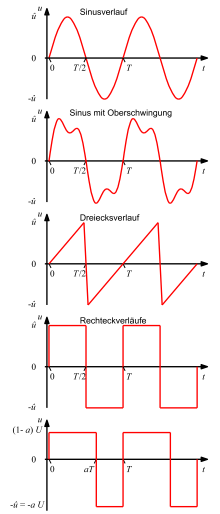Period (physics)
In the case of a physical phenomenon that is not constant but regularly recurs, the period is the smallest spatial or temporal interval after which the process repeats. The term period is preferably used for oscillations and waves .
Vibrations
Determinations
Vibrations are exclusively functions of time. The period is also called period duration or oscillation duration (rarely: oscillation time ). They are usually referred to with the formula symbol and indicated in the unit of measurement seconds with the unit symbol s. Examples of periodic functions in the form of alternating voltages are shown in the picture.
The relationship is characteristic of the periodicity according to time
- for any time and for = const> 0.
The reciprocal value is called frequency (symbol: or (ny)).
-
Example : The alternating current common in Europe has a frequency of 50 Hz and thus a period of
The sinusoidal or harmonic oscillation is often not described as a function of time , but as a function of the phase angle .
with the angular frequency
Then the period corresponds exactly to one revolution with the full angle
With frequency modulation , the period is also modulated, but it remains constant on average over time.
In addition to harmonic oscillations, there are generally periodic oscillations . These include, for example, periodically switched processes ( pulse trains ) and stepped periodic processes ( digital signals ), so that a period duration is also characteristic for these. For example, the pulse width modulation works with a constant pulse period with a modulated pulse duration.
Measurement
The period is mainly measured by electronic counting circuits . A clock signal is counted that oscillates as precisely as possible with an integer power of ten of the unit Hertz. The duration of the count is limited by exactly one period of the frequency to be measured (or a power of ten multiple thereof). In order to achieve a small relative quantization deviation , a high count is aimed for.
-
Example : A reference clock oscillates exactly at 10 6 Hz = 1 MHz and generates counting pulses at an interval of 1 μs. If this clock is counted for a limited period for the duration of an unknown period and if the counter reading is 50, the period is 50 μs.
If over 1000 periods are counted, the counter reading is a thousand times larger. This is divided by 1000 using a comma shift; for the counter reading 50020, the period is 50.020 μs.
Instead of measuring the period, the frequency can also be measured and then converted if the period is relatively short. Then the number of periods is counted in a fixed time. To do this, the time is derived from the reference clock.
- Example with the same data as before: At = 50 μs, = 20 kHz is expected. If the number of oscillation periods is counted for 10 6 periods of the reference frequency, i.e. for 1 s, the measured value for a counter reading of 19992 is 19992 Hz and the converted measurement result is 50.020 μs.
waves
Waves are functions of both time and place. A distinction must be made here between
- Period duration for processes that are repeated after a fixed time interval ( periodically) and
- Period length for processes that repeat themselves after a fixed distance in space ( spatially periodic).
For a simple sinusoidal wave with the position coordinate , the argument
used. Here stands for the period length or wavelength , the reciprocal value for the spatial frequency or wave number . For a wave advancing in the direction, the minus sign applies.
















